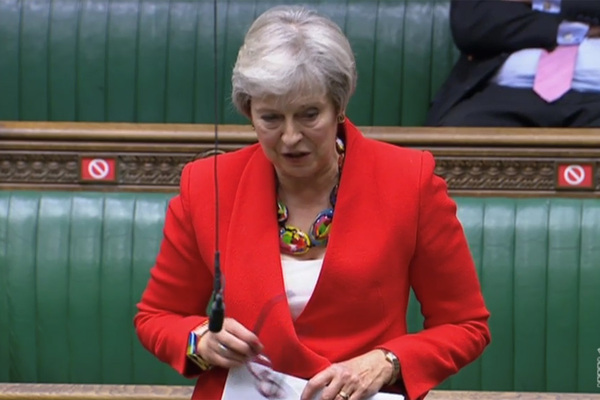You are viewing 1 of your 1 free articles
 Jules Birch
Jules BirchPlanning reform proposals lay bare the tensions in Conservative politics
Central government’s bid to push housebuilding numbers by reforming the planning system is at odds with local Conservatives’ political priorities. Jules Birch considers the results
Remember when a newly elected Conservative-led government was determined to put an end to top-down planning and scrap Labour’s ‘Stalinist’ housebuilding targets?
It may be only 10 years ago, but all that ‘localism’ seems a long time ago in the wake of a Planning White Paper that Boris Johnson says will deliver “radical reform unlike anything we have seen since the Second World War”.
But that 2010 rhetoric from Eric Pickles and Grant Shapps is a reminder of the tensions that are inherent in the conflict between Conservative determination to deliver more homes from the centre and the conservative impulse to resist them at a local level.
For all the lofty promises about “big, bold steps so that we in this country can finally build the homes we all need and the future we all want to see”, that struggle has never gone away.
Already, with another week of consultation on the white paper still to go, ministers are signalling a U-turn on a key part of it after a revolt by Tory backbenchers.
In a debate in the Commons a couple of weeks ago, MPs including former prime minister Theresa May lined up to criticise the local housebuilding targets implied by the new standard method for assessing housing need that they dubbed a “mutant algorithm”.
“Tensions were inevitable after a white paper was designed to sweep away the ‘socialism’ of the 1947 Town and Country Planning Act at the same time as it retained the system of green belts that it had helped to enable”
Former minister Caroline Nokes even reminded Christopher Pincher that “the housing minister and I were first elected on a manifesto that committed to no more top-down housing targets, and this algorithm looks suspiciously like a top-down target”.
Mr Pincher promised: “Our changes to the standard method in the short term will be just a starting point. We know that the housing numbers generated by the standard method will not necessarily be the numbers that areas plan for, because of the physical and geographic constraints placed on them.”
Tensions were inevitable after a white paper was designed to sweep away the ‘socialism’ of the 1947 Town and Country Planning Act at the same time as it retained the system of green belts that it had helped to enable.
At the heart of the proposals is a new system of zoning that will see land designated as growth, renewal or protected areas.
There is nothing wrong with zoning as such. While many complain about the loss of the democratic right to object to individual developments, the way that I’ve phrased that indicates a big problem with the current system. If zoning is simpler and more transparent it should speed up planning, reduce costs and see more homes built.
The problem arises, I think, when the design for a new system that makes sense on paper is compared with the imperfect results of the old one in the real world.
For example, the white paper does not mention highways, even though details about traffic flows and parking are a major obstacle to many developments. Expect even more nimbyism disguised as concern about traffic under the new system.
Or take Section 106. This is an imperfect compromise between doing nothing to tax the profits made by landowners from planning permission and the original 1947 idea of a 100% betterment tax. Far from being ‘socialist’, it was introduced by Margaret Thatcher’s Conservative government in 1990.
“The idea of settling which land can be developed for homes with one decision on zoning sounds simpler, but it could still come down to a contest between the best-organised and best-financed interests”
The white paper would replace Section 106 and the Community Infrastructure Levy with a new flat rate Infrastructure Levy that it claims will “sweep away months of negotiation” and “deliver at least as much – if not more – on-site affordable housing as at present”.
That is at best a breezy assertion when the current system delivered 30,000 affordable homes in 2018/19 and the Local Government Association says the new one would have delivered 30,000 fewer over the past five years.
If most of the money (£4.7bn of the £7bn) raised in planning obligations went on affordable housing, why call it merely the Infrastructure Levy?
And how affordable will they be in any case by the time First Homes have taken their share?
Similarly, the idea of settling which land can be developed for homes with one decision on zoning sounds simpler, but it could still come down to a contest between the best-organised and best-financed interests. Those would still be existing homeowners and developers rather than people who need homes.
That might not matter if the new system delivers what it promises – more new homes in the least affordable areas – but will it?
Decisions have already been taken to protect the green belt and other environmental and heritage assets. While this might be justifiable on environmental grounds, this rules out development in areas outside existing settlements in Tory-held seats in the most expensive parts of the country.
To take one example, Chipping Barnet is a constituency on the edge of north London. Its MP Theresa Villiers is one of the organisers of the Tory backbench rebellion on the white paper.
But she devotes a page on her website not just to protecting the green belt and green spaces, but also to “fighting over-development”.
“The government still hasn’t explained why house builders would build homes any faster than the market can absorb at prices that deliver their required profit margins”
Alongside the Conservative candidate for London mayor, she campaigns against Transport for London’s plans to turn the car parks of suburban stations into homes.
If the idea is to build more new homes in areas where existing ones cost the most, then Chipping Barnet (average price £535,000) should be a prime candidate, but not if you can’t build out and you can’t build up.
So there are good reasons to doubt whether the new system will deliver what the government says, given the parameters already set and what look like being inevitable concessions to Tory backbenchers. Will tweaks to the algorithm be enough to satisfy them?
If it does press ahead, the government still hasn’t explained why house builders would build homes any faster than the market can absorb at prices that deliver their required profit margins.
The glossy version of the white paper is full of pictures of well-planned new developments like Poundbury in Dorset, Tregunnel Hill and Nansledan in Cornwall, and Campbell Park in Milton Keynes.
All of these were of course delivered under a system that the white paper calls “a relic” from the middle of the 20th century. All of them involved enlightened landowners and good design, but only one involved a volume house builder.
The proposed new system may be the culmination of the fix planning = fix supply = fix housing argument, but will it really turn out to be that simple?
Jules Birch, columnist, Inside Housing
Sign up for our development and finance newsletter
Already have an account? Click here to manage your newsletters













